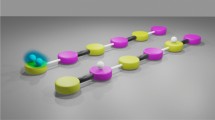Abstract
We explore the properties of the bipolaron in a 1D Holstein–Hubbard model with dynamical quantum phonons. We apply strong coupling theory to investigate the intersite bipolaron. We investigate the influence of the Hubbard interaction on the bipolaron binding energy, effective mass, and phase diagram. We compare our analytic results to recent numerical calculations [1]. In the intermediate and strong coupling regimes, a bipolaron is stable beyond the naive stability limit U 0 = 2ωg 2. The intersite bipolaron has a significantly reduced mass compared to the single site bipolaron, and is stable in the strong coupling regime up toU c ∼ 4ωg 2.
Similar content being viewed by others
REFERENCES
J. Bonča, T. Katrašnik, and S. A. Trugman, Phys. Rev. Lett. 84, 3153 (2000).
Lattice Effects in High-T c Superconductors, Y. Bar-Yam, T. Egami, J. Mustre de Leon, and A. R. Bishop, eds. World Scientific, Singapore (1992).
E. K. H. Salje, A. S. Aleksandrov, and W. Y. Liang, Polarons and Bipolarons in High Temperature Superconductors and Related Materials. Cambridge University Press, Cambridge (1995); A. S. Alexandrov and N. F. Mott, Rep. Progr. Phys. 57, 1197 (1994).
M. Grilli and C. Castellani, Phys. Rev. B 50, 16880 (1994).
G. Wellein, H. Röder, and H. Fehske, Phys. Rev. B 53, 9666 (1996).
F. Marsiglio, Physica C 244, 21 (1995).
A. S. Alexandrov and V. V. Kabanov, Sov. Phys. Solid State 28, 631 (1986).
E. V. L. de Mello and J. Ranninger, Phys. Rev. B 58, 9098 (1998).
B. K. Chakraverty, J. Ranninger, and D. Feinberg, Phys. Rev. Lett. 81, 433 (1998).
A. S. Alexandrov and N. F. Mott, High Temperature Superconductors and Other Superfluids. Taylor and Francis, London (1994); A. S. Alexandrov, V. V. Kabanov, and N. F. Mott, Phys. Rev. Lett. 53, 2863 (1996).
L. Proville and S. Aubry, Physica D 133, 307 (1998); L. Proville and S. Aubry, preprint; S. Aubry, in Proceedings of “Phase Separation in Cuprate Superconductors,” K. A. Muller and G. Benedek, eds. Erice, Sicily, World Scientific (1992), p. 304. The last reference discusses the possible role of S1 bipolarons in cuprate superconductors.
A. La Magna and R. Pucci, Phys. Rev. B 55, 14886 (1997).
G. D. Mahan, Many-Particle Physics, Plenum, New York (1981).
J. Bonča and S. A. Trugman, Phys. Rev. Lett. 75, 2566 (1995).
J. Bonča, S. A. Trugman, and I. Batistič, Phys. Rev. B 60, 1633 (1999).
I. G. Lang and Yu. A. Firsov, Sov. Phys. JETP 16, 1301 (1963); Sov. Phys. Solid State 5, 2049 (1964).
Author information
Authors and Affiliations
Rights and permissions
About this article
Cite this article
Bonča, J., Trugman, S.A. Mobile Bipolaron—Strong Coupling Approach. Journal of Superconductivity 13, 999–1003 (2000). https://doi.org/10.1023/A:1026466711595
Issue Date:
DOI: https://doi.org/10.1023/A:1026466711595




